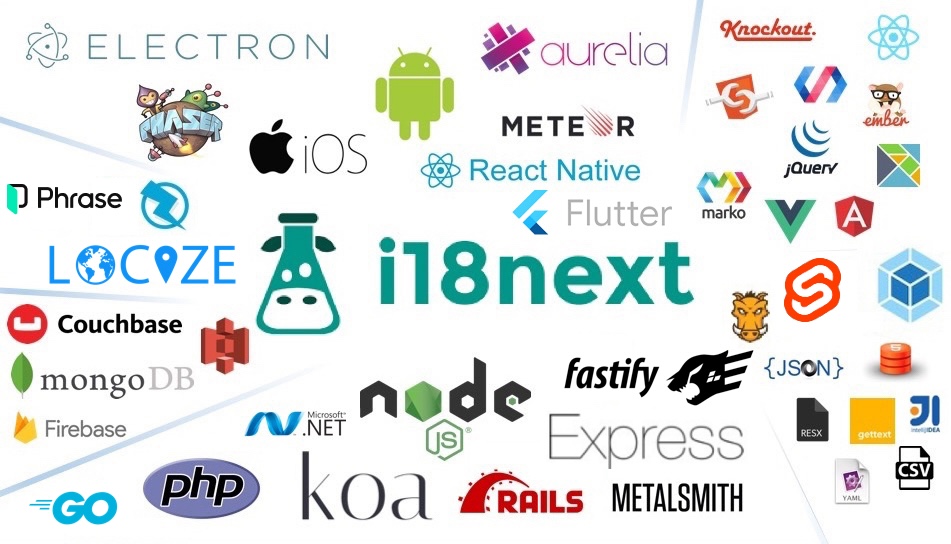Framework Integration
- i18next:
i18nextis designed to work with multiple frameworks, including React, Vue, and Angular. It provides plugins and components for seamless integration, making it versatile for cross-framework projects. - intl-messageformat:
intl-messageformatis a standalone library for formatting messages according to the ECMAScript Internationalization API. It does not provide framework-specific features but can be used in any JavaScript environment. - react-intl:
react-intlis specifically built for React applications. It provides React components and hooks for internationalization, making it easy to integrate i18n into React projects. - vue-i18n:
vue-i18nis tailored for Vue.js applications. It integrates with Vue’s reactivity system and provides a simple API for managing translations and locales. - @messageformat/core:
@messageformat/coreis framework-agnostic and can be used with any JavaScript application. It focuses on message formatting rather than providing integration with specific frameworks.
Pluralization Support
- i18next:
i18nextsupports pluralization out of the box, allowing developers to define plural forms in translation files. It provides a simple API for handling pluralization based on the count value. - intl-messageformat:
intl-messageformatsupports pluralization as defined by the ECMAScript Internationalization API. It allows developers to create messages with multiple plural forms, making it suitable for languages with complex pluralization rules. - react-intl:
react-intlsupports pluralization through theFormattedPluralcomponent and theIntl.PluralAPI. It allows developers to define plural rules in their messages, making it easy to handle pluralization in React applications. - vue-i18n:
vue-i18nsupports pluralization by allowing developers to define plural forms in their translation messages. It provides a simple syntax for handling pluralization, making it easy to implement in Vue applications. - @messageformat/core:
@messageformat/coreprovides advanced pluralization support, allowing developers to define plural rules for different languages. It supports multiple plural forms and can handle complex pluralization scenarios.
Message Formatting
- i18next:
i18nextprovides flexible message formatting with support for interpolation, nesting, and pluralization. It allows developers to create dynamic and context-aware messages, making it suitable for applications with complex translation needs. - intl-messageformat:
intl-messageformatfocuses on formatting messages according to the Internationalization API standards. It supports interpolation, pluralization, and gender formatting, providing a standardized way to handle messages in multilingual applications. - react-intl:
react-intloffers comprehensive message formatting capabilities, including support for interpolation, pluralization, and rich text. It provides a set of components and APIs that make it easy to format messages in a React context. - vue-i18n:
vue-i18nprovides message formatting features with support for interpolation, pluralization, and dynamic translations. It allows for flexible and reactive message rendering, making it easy to implement i18n in Vue applications. - @messageformat/core:
@messageformat/corespecializes in message formatting, providing features like interpolation, pluralization, and gender-based formatting. It allows for highly customizable message structures, making it suitable for applications that require precise control over how messages are displayed.
Size and Performance
- i18next:
i18nextis a feature-rich library that may have a larger footprint due to its extensive capabilities. However, it is designed to be efficient, and developers can optimize performance by using features like lazy loading and code splitting. - intl-messageformat:
intl-messageformatis a lightweight library that provides efficient message formatting. Its compliance with the Internationalization API ensures that it performs well while handling complex formatting tasks. - react-intl:
react-intlhas a moderate size, but its performance is optimized for use in React applications. Developers can minimize performance impacts by using the library’s features efficiently and avoiding unnecessary re-renders. - vue-i18n:
vue-i18nis designed to be lightweight and efficient, making it suitable for Vue applications. Its performance is optimized for reactive updates, ensuring smooth rendering of translations. - @messageformat/core:
@messageformat/coreis a lightweight library focused on message formatting. Its small size and efficient algorithms make it suitable for performance-sensitive applications that require fast message processing.
Ease of Use: Code Examples
- i18next:
Simple Example with
i18nextimport i18next from 'i18next'; i18next.init({ lng: 'en', resources: { en: { welcome: 'Welcome, {name}!', }, fr: { welcome: 'Bienvenue, {name}!', }, }, }); const welcomeMessage = i18next.t('welcome', { name: 'Alice' }); console.log(welcomeMessage); // Output: Welcome, Alice! - intl-messageformat:
Message Formatting with
intl-messageformatimport { IntlMessageFormat } from 'intl-messageformat'; const message = new IntlMessageFormat(`Hello, {name}. You have {count, plural, =0 {no messages} =1 {one message} other {# messages}}.`, 'en'); const formattedMessage = message.format({ name: 'Alice', count: 2 }); console.log(formattedMessage); // Output: Hello, Alice. You have 2 messages. - react-intl:
Message Formatting with
react-intlimport { IntlProvider, FormattedMessage } from 'react-intl'; const messages = { en: { greeting: 'Hello, {name}!', }, fr: { greeting: 'Bonjour, {name}!', }, }; const App = () => ( <IntlProvider locale='en' messages={messages.en}> <FormattedMessage id='greeting' values={{ name: 'Alice' }} /> </IntlProvider> ); - vue-i18n:
Simple Example with
vue-i18nimport { createApp } from 'vue'; import { createI18n } from 'vue-i18n'; const i18n = createI18n({ locale: 'en', messages: { en: { hello: 'Hello, {name}!', }, fr: { hello: 'Bonjour, {name}!', }, }, }); const app = createApp({ template: `<div>{{ $t('hello', { name: 'Alice' }) }}</div>`, }); app.use(i18n); app.mount('#app'); - @messageformat/core:
Message Formatting with
@messageformat/coreimport { MessageFormat } from '@messageformat/core'; const mf = new MessageFormat('en'); const message = mf.compile`Hello, {name}. You have {count, plural, =0 {no messages} =1 {one message} other {# messages}}.`; console.log(message({ name: 'Alice', count: 2 })); // Output: Hello, Alice. You have 2 messages.








